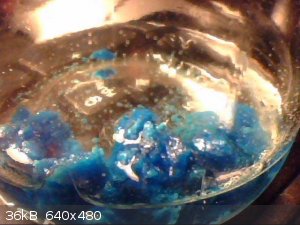wg48
National Hazard
   
Posts: 821
Registered: 21-11-2015
Member Is Offline
Mood: No Mood
|
|
Copper glycerol jelly ?
I tried to make a Liesegang pattern with copper sulphate dissolved in glycerol and ammonia vapour. Not very successful. I added ammonia solution but
just one ring formed and eventually the whole solution turned deep purple/blue. When I was about to dispose of the experiment I discoverd there was a
deep purple blue coloured jelly at the bottom of the tube that looked like it contained crystals of the same color..
I removed the jelly. No crystals the jelly had fractured causing the appearance of crystals I dried it at 100C and some glycerol oozed from the
jelly. It did not dissolve in the cold or hot water and is only slightly soluble in dilute NaOH. It does dissolve in dilute HCl to a light greenish
solution.
On heating there is no obvious smell of ammonia but I did get a very acrid whiff of something. On heating below dull red heat the jelly decomposes
with occasional pops to leave a black slight copper coloured deposit.
I speculate the jelly is a polymer copper glycerolate or more accurately a complex copper glycerol with sulphate as the counter ion and perhaps some
ammonia.
I am trying to wash the jelly of any glycerol with acetone at present see the pic. The color is very very similar to copper sulphate hydrate.

|
|
|
Cryolite.
Hazard to Others
  
Posts: 269
Registered: 28-6-2016
Location: CA
Member Is Offline
Mood: No Mood
|
|
I have no idea about the complex, but the acrid whiff you caught was most likely acrolein formed by dehydration of the glycerol under catalysis by the
copper.
|
|
|
wg48
National Hazard
   
Posts: 821
Registered: 21-11-2015
Member Is Offline
Mood: No Mood
|
|
Quote: Originally posted by Cryolite.  | | I have no idea about the complex, but the acrid whiff you caught was most likely acrolein formed by dehydration of the glycerol under catalysis by the
copper. |
Yes thats what I figured as well. Perhaps super acrid would have been more accurate. It certainly detered me from smelling it again and may have
masked any smell of ammonia.
Glycerol is known to form complexes with copper at high pH thats probably what the jelly is. It may involve the ammonia too.
The jelly is air stable to 100C(pre acetone wash) and acetone wash stable. When incubated with water at 100C for a round 30min the jelly converts to a
brown friable mass. Presumably copper oxide and or copper.
I just checked the container of jelly and it has a distinct smell of ammonia.
|
|
|
PHILOU Zrealone
International Hazard
    
Posts: 2893
Registered: 20-5-2002
Location: Brussel
Member Is Offline
Mood: Bis-diazo-dinitro-hydroquinonic
|
|
By heating Pb(OH)2 with glycerol one can get lead-glycerolate
Pb(OH)2 + HOCH2-CHOH-CH2OH -heat-> *Pb-OCH2-CHO*-CH2OH + 2 H2O(g)
The compound is mildly explosive when heated dry into a hot flame.
I suspect Cu(OH)2 in NH4OH did the same kind of compound...
PH Z (PHILOU Zrealone)
"Physic is all what never works; Chemistry is all what stinks and explodes!"-"Life that deadly disease, sexually transmitted."(W.Allen)
|
|
|
wg48
National Hazard
   
Posts: 821
Registered: 21-11-2015
Member Is Offline
Mood: No Mood
|
|
Quote: Originally posted by PHILOU Zrealone  | By heating Pb(OH)2 with glycerol one can get lead-glycerolate
Pb(OH)2 + HOCH2-CHOH-CH2OH -heat-> *Pb-OCH2-CHO*-CH2OH + 2 H2O(g)
The compound is mildly explosive when heated dry into a hot flame.
I suspect Cu(OH)2 in NH4OH did the same kind of compound... |
Yes I believe your correct. I was calling it a glycerol complex. as per this paper http://psasir.upm.edu.my/8995/1/FPP_1998_12_A.pdf
Incidently I placed a dry mixture NaOH and NH4OH wrapped up in a filter paper in the storage jar with the jelly to re-ammoniumate it . I thought
since the jelly was dried and washed with acetone. the colour had significantly changed from midnight blue to a more copper sulphate blue.
Within minuts the colour of the jelly (or more accuratly crumble since it has been dryed and washed) turned a deep midnight blue and the surface
appeared to be shiny more like the orginal jelly. Hours later it had partilly melted. Both the liquid and solid were now the dark midnight blue
color.
Prevously I had only seen the copper complex (gylcerolate) in a solution. Perhaps in a more concentrated solution it forms a jelly.
|
|
|